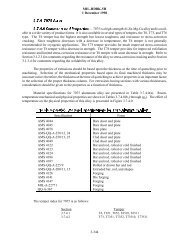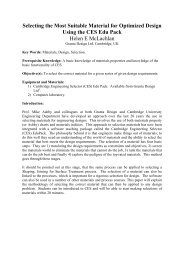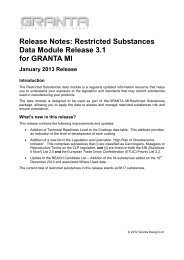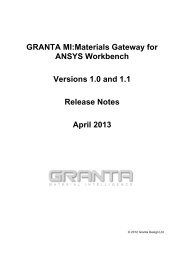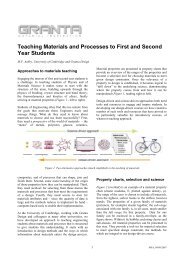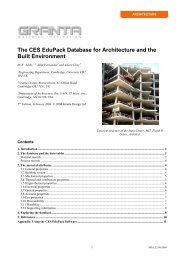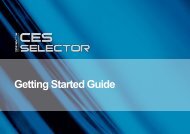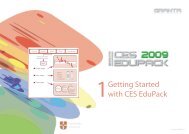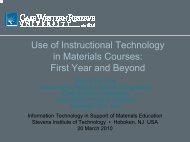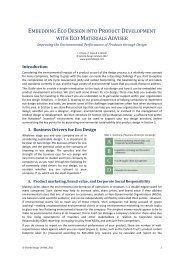60% or more of the energy—often much more.If large energy savings are to be achieved, it isthe dominant phase that becomes the firsttarget since it is here that a given fractionalreduction makes the biggest contribution. Thesecond: when differences are as great asthose of Figure 4, great precision is notnecessary—modest changes to the input dataleave the ranking unchanged. It is the natureof people who measure things to wish to do sowith precision, and precise data must be theultimate goal. But it is possible to moveforward without it: precise judgments can bedrawn from imprecise data.3. Base the subsequent action on theenergy or carbon breakdown.Figure 5 suggests how the strategy can beimplemented. If material production is thedominant phase, then minimizing the mass ofmaterial used and choosing materials with lowembodied energy are logical ways forward. Ifmanufacture is an important energy-usingphase of life, reducing processing energiesbecomes the prime target. If transport makesa large contribution, then seeking a moreefficient transport mode or reducing distancebecomes the first priority. When the usephasedominates the strategy is that ofminimizing mass (if the product is part of asystem that moves), or increasing thermalefficiency (if a thermal or thermo-mechanicalsystem), or reducing electrical losses (if anelectro-mechanical system). In general thebest material choice to minimize one phasewill not be the one that minimizes the others,requiring trade-off methods to guide thechoice. A full description of these and othermethods for materials selection can be foundin reference (2).Implementation requires tools. Two sets areneeded, one to perform the eco auditsketched in the upper part of Figure 5, theother to enable the analysis and selectionsketched in the lower part. The purpose of thiswhite paper is to describe the first: the <strong>Eco</strong><strong>Audit</strong> Tool.4. The <strong>Eco</strong> <strong>Audit</strong> ToolFigure 6 shows the structure of the tool. Theinputs are of two types. The first are drawnfrom a user-entered bill of materials, processchoice, transport requirements and duty cycleFigure 5. Rational approaches to the eco design of products start with an analysis of the phase of lifeto be targeted. Its results guide redesign and materials selection to minimize environmental impact.The CES EduPack <strong>Eco</strong> <strong>Audit</strong> Tool 4 © 2012, <strong>Granta</strong> <strong>Design</strong>
(the details of the energy and intensity of use),and disposal route. Data for embodiedenergies and process energies are drawnfrom a database of material properties; thosefor the energy and carbon intensity oftransport and the energy sources associatedwith use are drawn from look-up tables. Theoutputs are the energy or carbon footprint ofeach phase of life, presented as bar chartsand in tabular form.Figure 6. The <strong>Eco</strong> <strong>Audit</strong> Tool. The model combinesuser-defined inputs with data drawn from databases ofembodied energy of materials, processing energies, andtransport type to create the energy breakdown. Thesame tool can be used for an assessment of CO 2footprint.The tool in detail. The tool is opened fromthe “Tools” menu of the CES EduPacksoftware toolbar by clicking on “<strong>Eco</strong> <strong>Audit</strong>”.Figure 7 (overleaf) is a schematic of the userinterface that shows the user actions and theconsequences. There are four steps, labeled1, 2, 3, and 4. Actions and inputs are shown inred.Step 1, material and manufacture allowsentry of the mass, the material and primaryshaping process for each component. Thecomponent name is entered in the first box.The material is chosen from the pull-downmenu of box 2, opening the database ofmaterials properties 1 . Selecting a materialfrom the tree-like hierarchy of materialscauses the tool to retrieve and store itsembodied energy and CO 2 footprint per kg.The primary shaping process is chosen fromthe pull-down menu of box 3, which lists theprocesses relevant for the chosen material;the tool again retrieves energy and carbonfootprint per kg. The last box allows thecomponent weight to be entered in kg. Oncompleting a row-entry a new row appears forthe next component.On a first appraisal of the product it isfrequently sufficient to enter data for thecomponents with the greatest mass,accounting for perhaps 95% of the total. Theresidue is included by adding an entry for“residual components” giving it the massrequired to bring the total to 100% andselecting a proxy material and process:“polycarbonate” and “molding” are goodchoices because their energies and CO 2 lie inthe mid range of those for commoditymaterials.The tool multiplies the energy and CO 2 per kgof each component by its mass, and totalsthem. In its present form the data for materialsare comprehensive. Those for processes arerudimentary.Dealing with end of life. There are fiveoptions for disposal at the end of life: landfill,combustion for energy recovery, recycling, reengineer,and reuse. A product at end of firstlife (Figure 8) has the ability to return part orall of its embodied energy. This at first soundswrong—much of the “embodied” energy wasnot embodied at all but was lost as low-gradeheat via the inefficiencies of the processingplant, and even when it is still there, it is, formetals and ceramics, inaccessible since theonly easy way to recover energy directly is by1 One of the CES EduPack Materials databases,depending on which was chosen when the software wasopened.The CES EduPack <strong>Eco</strong> <strong>Audit</strong> Tool 5 © 2012, <strong>Granta</strong> <strong>Design</strong>



